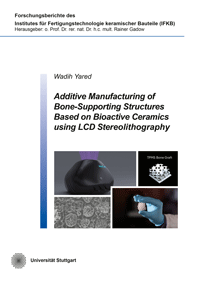
Shop : Details
Shop
Details

April 2025
Wadih Yared
Additive Manufacturing of Bone-Supporting Structures Based on Bioactive Ceramics using LCD Stereolithography
This research focuses on developing biocompatible and bioresorbable ceramic bone grafts using LCD stereolithography, an additive manufacturing (AM) process known for its high precision and surface quality. The study covers key stages from material selection and CAD design to resin formulation, manufacturing optimization, and final characterization. Special emphasis is placed on creating ceramic-filled resins by distilling monomers, functionalizing ceramic powders, and ensuring proper dispersion to prevent agglomerates that cause defects. The curing kinetics of these resins are enhanced by optimizing photoinitiators and oligomer concentrations to improve cross-link density.
To control scaffold porosity, the study employs sacrificial templating, using emulsion polymerized PS particles as templates. This technique enables the fabrication of scaffolds with tailored pore sizes and morphologies after debinding and sintering. Additionally, mechanical modifications to the LCD system and the development of custom devices like the Wadih-mat lithography machine and a photorheological accessory support efficient resin testing and curing characterization.
Geometric manufacturability is assessed by testing minimum bore diameters, wall thicknesses, unsupported bridges, and abrupt thickness changes. The study also explores machine learning models to optimize process parameters, reducing reliance on subjective expertise. The research concludes with guidelines for Good Research Practices (GRP) in ceramic AM using LCD stereolithography, ensuring reliable and reproducible bone graft production.
To control scaffold porosity, the study employs sacrificial templating, using emulsion polymerized PS particles as templates. This technique enables the fabrication of scaffolds with tailored pore sizes and morphologies after debinding and sintering. Additionally, mechanical modifications to the LCD system and the development of custom devices like the Wadih-mat lithography machine and a photorheological accessory support efficient resin testing and curing characterization.
Geometric manufacturability is assessed by testing minimum bore diameters, wall thicknesses, unsupported bridges, and abrupt thickness changes. The study also explores machine learning models to optimize process parameters, reducing reliance on subjective expertise. The research concludes with guidelines for Good Research Practices (GRP) in ceramic AM using LCD stereolithography, ensuring reliable and reproducible bone graft production.
Keywords: Additive Manufacturing; Bone regeneration; Stereolithography; Ceramics
Forschungsberichte des Instituts für Fertigungstechnologie keramischer Bauteile (IFKB)
Edited by o. Prof. Dr. rer. nat. Dr. h.c. mult. Rainer Gadow, Stuttgart
Other formats
Electronic publication (PDF): 978-3-8191-0026-0
Export of bibliographic data
Shaker Verlag GmbH
Am Langen Graben 15a
52353 Düren
Germany
Am Langen Graben 15a
52353 Düren
Germany
Mon. - Thurs. 8:00 a.m. to 4:00 p.m.
Fri. 8:00 a.m. to 3:00 p.m.
Fri. 8:00 a.m. to 3:00 p.m.
Contact us. We will be happy to help you.

